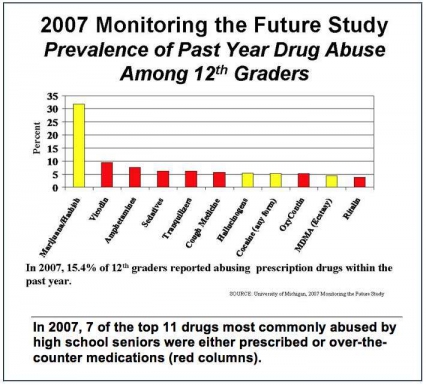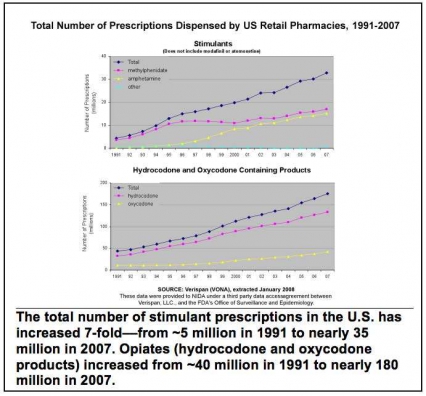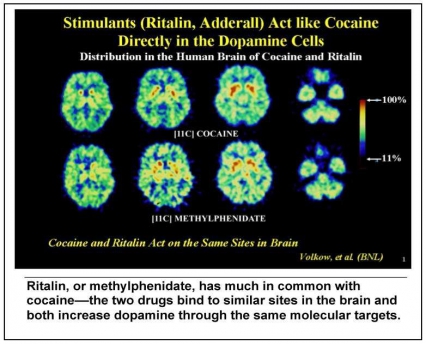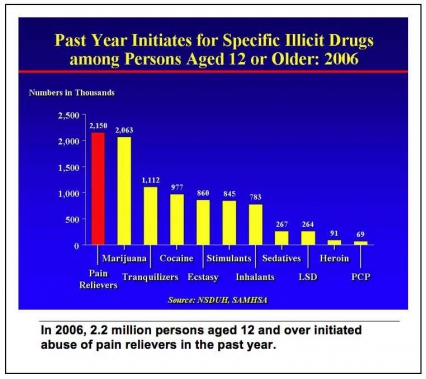Mr. Chairman, Members of the Subcommittee, and Members of the Caucus:
Thank you for inviting the National Institute on Drug Abuse (NIDA), a component of the National Institutes of Health (NIH), an agency of the Department of Health and Human Services (HHS), to participate in this important hearing and contribute information about the growing problem of prescription drug abuse in this country. This problem is particularly complex because the benefits and the risks of prescription drugs are so closely intertwined. Thus, it is critical that we learn how to strike the right balance between providing maximum relief from suffering and minimizing associated risks and adverse effects. We must be deeply concerned by the fact that, according to the Monitoring the Future (MTF) study supported by NIDA, 7 of the top 11 most commonly abused drugs by high school seniors are either prescribed or purchased over-the-counter (see figure), but this challenge must also recognize the fundamental and unassailable role played by these medications in healing and reducing human suffering when properly used. Therefore, how we address the problem of abuse of drugs that have legitimate medical use must necessarily differ from how we address illicit drug abuse.
 In 2007, 7 of the top 11 drugs most commonly abused by high school seniors were either prescribed or over-the-counter medications (red columns)
In 2007, 7 of the top 11 drugs most commonly abused by high school seniors were either prescribed or over-the-counter medications (red columns)Several factors have recently contributed to the severity of prescription drug abuse, including drastic increases in the number of prescriptions written, greater social acceptance of using medications, and aggressive marketing by pharmaceutical companies. These factors together have helped create the broad "environmental availability" of prescription drugs. To illustrate, the total number of stimulant prescriptions in the U.S. has soared from around 5 million in 1991 to nearly 35 million in 2007. Prescriptions for opiates (hydrocodone and oxycodone products) have escalated from around 40 million in 1991 to nearly 180 million in 2007 (see figure), with the U.S. their biggest consumer. The U.S. is supplied 99 percent of the world total for hydrocodone (e.g., Vicodin) and 71 percent of oxycodone (e.g., OxyContin).
 The total number of stimulant prescriptions in the U.S. has increased 7-fold - from ∼5 million in 1991 to nearly 35 million in 2007. Opiates (hydrocodone and oxycodone products) increased from ∼40 million in 1991 to nearly 180 million in 2007
The total number of stimulant prescriptions in the U.S. has increased 7-fold - from ∼5 million in 1991 to nearly 35 million in 2007. Opiates (hydrocodone and oxycodone products) increased from ∼40 million in 1991 to nearly 180 million in 2007This greater availability of prescription drugs has been accompanied by increases in their abuse. To clarify our terminology here, when we say "prescription drug abuse" or "nonmedical use," this includes use of approved prescription medications without a prescription, use for purposes other than prescribed, or use simply for the experience or feeling the drug can cause. Unlike illicit drug use, which shows a continuing downward trend, prescription drug abuse, particularly of opioid pain medications, has seen a continual rise through the 1990s and has remained stubbornly steady among persons 12 or older during recent years. 1 Because prescription drugs act directly or indirectly on the same brain systems affected by illicit drugs, their abuse carries substantial abuse and addiction liabilities. They are most dangerous when taken to get high via methods that increase their addictive potential (e.g., crushing the pills, then snorting or injecting their contents, or combining them with alcohol or illicit drugs). Some people also take prescription drugs for their intended purpose, though not as prescribed, thus heightening the risk of dangerous adverse reactions; and still others may become addicted even when they take them as prescribed. Given that more than 30 million people suffer from chronic pain in this country, even if a fraction of this group takes prescription drugs for their pain and becomes addicted, it could affect a large number of people.
I am pleased to have the opportunity today to share with you what we know about this complex multi-faceted problem.
Which medications are being abused, and what do they do to the brain and body?
The psychotropic prescription drugs2 that present abuse liability (i.e., have potential for abuse relative to their pharmacological and behavioral effects) fall into three broad categories: opioids (analgesics), stimulants, and central nervous system (CNS) depressants (anxiety and sleep medications). How they work is described briefly below:
 Ritalin, or methylphenidate, has much in common with cocaine - the two drugs bind to similar sites in the brain and both increase dopamine through the same molecular targets.
Ritalin, or methylphenidate, has much in common with cocaine - the two drugs bind to similar sites in the brain and both increase dopamine through the same molecular targets.- Opioids, mostly prescribed to treat moderate to severe pain, include drugs such as OxyContin and Vicodin. Opioids act on the brain and body by attaching to specific cell surface proteins called opioid receptors, which are found in the brain, spinal cord, and gastrointestinal tract. When these drugs attach to certain opioid receptors, they can block the perception of pain. These drugs also can induce euphoria by indirectly boosting dopamine levels in the brain regions that influence our perceptions of pleasure. This feeling is often intensified by abusers who snort or inject the drugs, amplifying their euphorigenic effects and increasing the risk for serious medical consequences, such as respiratory arrest, coma, and addiction. Combining opioids with alcohol can exacerbate these consequences.
- Stimulants, prescribed to treat attention-deficit hyperactivity disorder (ADHD) and narcolepsy, include drugs such as Ritalin, Adderall, and Concerta. These prescription medications stimulate the central nervous system, with effects similar to but more potent than caffeine. When taken orally, as prescribed, these stimulants elicit a gradual and sustained increase in the neurotransmitter (brain chemical) dopamine, which produces the expected therapeutic effects seen in many patients. In people with ADHD, stimulant medications generally have a calming and "focusing" effect, particularly in children. However, because these medications affect the dopamine system in the brain (the reward pathway), they are also similar to drugs of abuse. For example, Ritalin, or methylphenidate, has much in common with cocaine - the two drugs bind to similar sites in the brain and both increase dopamine through the same molecular targets (see figure). When administered intravenously, both drugs cause a rapid and large increase in dopamine, which a person experiences as a rush or high. For those who abuse stimulants, the range of adverse health consequences includes risk of dangerously high body temperature, seizures, and cardiovascular complications.
- CNS depressants, typically prescribed for the treatment of anxiety, panic, sleep disorders, acute stress reactions, and muscle spasms, includes drugs such as Valium, Librium, and Xanax. Most CNS depressants act on the brain by affecting the neurotransmitter gammaaminobutyric acid (GABA). GABA works by decreasing brain activity. Although the different classes of CNS depressants work in unique ways, it is through their ability to increase GABA activity that they produce a drowsy or calming effect that is beneficial to those suffering from anxiety or sleep disorders. These drugs are also particularly dangerous when mixed with other medications or alcohol; overdose can cause breathing problems and lead to death. Although the newer sleep medications - such as Ambien, Lunesta, and Sonata - appear to have reduced dependence and abuse liabilities, they still react with some of the same receptors in the brain, so they may share some of the risks.
Over the counter medications, such as certain cough suppressants containing dextromethorphan (DXM), are also abused for their psychoactive effects, producing hallucinations and dissociative ("out-of-body") sensations. However, overdose of DXM can also produce confusion, disorientation, motor impairment, blurred vision, nausea, rapid or irregular heartbeat, high blood pressure, and loss of consciousness.
What is the scope of the prescription drug problem in this country?
Several indicators show that prescription drug abuse is a significant problem in the United States. According to the National Survey on Drug Use and Health (NSDUH), conducted by HHS's Substance Abuse and Mental Health Services Administration (SAMHSA), in 2006 approximately 7 million persons 12 and older took a psychotherapeutic drug for non-medical purposes in the 30 days before the survey. Most reported abusing opiate pain relievers in particular. In fact, 2.2 million persons aged 12 and over initiated abuse of pain relievers in the past year (see figure). Young adults (ages 18-25) by far showed the greatest use overall and the largest increases in past month, past year, and lifetime use between 2002 and 2006, compared to all other age groups (NSDUH, 2007). Still, even by the time they graduate from high school, roughly a quarter of 12th graders report having abused a prescription drug (MTF, 2007). Other significant indicators of the prescription drug problem include the following:
- In 2006, more than half a million adolescents aged 12-17 used stimulants nonmedically in the past year (NSDUH, 2007).
- Although abuse of sedatives decreased among high school seniors between 2005 and 2007, it is still near peak levels, at over 6 percent among this group (MTF, 2007).
- Nearly 6 percent of 12th graders reported abusing cough medicine to get high in 2007 (MTF, 2007).
- Data on drug-related emergency department visits that involved prescription opioids show a 153 percent increase from 1995Ð2002, from 42,857 to 108,320 (SAMHSA's Drug Abuse Warning Network, 2004).
- Treatment admissions for opiates other than heroin surged from 16,121 in 1995 to 67,887 in 2005, a 321 percent increase (SAMHSA's Treatment Episode Data Set, 1995Ð2005).
- Prescribed pain medications are driving the upward trend in drug poisoning mortality. The number of deaths involving prescription opioid analgesics increased 160 percent in just 5 years from 1999 to 2004. By 2004, opioid painkiller abuse deaths outnumbered total deaths involving heroin and cocaine (HHS's Centers for Disease Control and Prevention, 2006).
What factors are driving abuse of prescription drugs?
The far-ranging scope of prescription drug abuse in this country stems not only from the greater prescribing of medications, but also from misperceptions of their safety. For example, many students, and even some parents, see nothing wrong in the abuse of stimulants to improve cognitive function and academic performance. In fact, being in college may even be a risk factor for greater use of amphetamines or Ritalin nonmedically, with reports of students taking pills before tests and of those with prescribed medications being approached to divert them to others. Pain relievers show a similar link with regard to access. Evidence suggests that parents sometimes provide their children with prescription medications not prescribed by a physician for the child to relieve their discomfort.3 According to the 2006 NSDUH, 55.7 percent of those 12 and older who misused pain relievers said they received their medications from a friend or family member, the vast majority of whom had gotten the drugs from just one doctor. Only 3.9 percent cited obtaining these drugs from a drug dealer or stranger, and only 0.1 percent cited an internet purchase. Notably, the leading reason for the abuse is to relieve pain, although other top motives include intent to get high and experimentation.
Similar motivations characterize younger groups, with high school students reporting that they primarily abuse prescription drugs for the medications' intended purpose, albeit without a prescription. Using these medications without a prescription or in ways other than prescribed poses multiple risks, including dangerous interactions with other medications, accidental poisoning, and risk of addiction.
Nonmedical use among children and adolescents is particularly troublesome, given that adolescence is the period of greatest risk not only for drug experimentation but also for developing addiction. At this stage, the brain is still developing and exposure to drugs could interfere with these carefully orchestrated developmental changes. Today we know that the last part of the brain to fully mature is the prefrontal cortex, a region that governs judgment and decision-making functions. This may help explain why teens are prone to risk-taking and to experimentation with alcohol and other drugs.
Research also shows that adolescents who abuse prescription drugs are twice as likely to have engaged in delinquent behavior and nearly three times as likely to have experienced an episode of major depression compared to teens who did not abuse prescription medications over the past year. Finally, several studies link the illicit use of prescription drugs with increased rates of cigarette smoking, heavy drinking, and marijuana and other illicit drug use in adolescents and young adults in the U.S.
Older adults represent another area for particular concern. Although this group currently comprises just 13 percent of the U.S. population, they receive approximately one-third of all medications prescribed in the Nation. In a culture in which medications are considered a "quick fix" for whatever ails you, combined with the greater rates of lifetime drug abuse among the "baby boom" generation as compared to those in the current older generation relative to its size, it is possible that the number of persons aged 50 or older abusing prescription drugs could increase 190 percent over the next two decades, from 911,000 in 2001 to almost 2.7 million in 2020.4 Because older adults also experience higher rates of other illness as well as normal changes in drug metabolism, it makes sense that even moderate abuse or unintentional misuse of prescription drugs by elderly persons could lead to more severe health consequences. Therefore, physicians need to be aware of the possibility of abuse and to discuss the health implications with their patients.
What is NIDA doing about it?
Recognizing the dangerous trend of prescription drug abuse as well as the need to promote additional research on the subject and to inform the public, physicians, pharmacists, and others, NIDA first launched its prescription drug abuse public health initiative in 2001. Through NIDA's support of surveillance instruments, including our Community Epidemiology Work Group and the Monitoring the Future survey, we continuously monitor trends in all forms of drug abuse, including the abuse of prescribed medications. In addition, NIDA and ONDCP are co-sponsoring an initiative on designing appropriate questions for screening and brief interventions for prescription drug abuse. Identifying trends as soon as they begin to surface in the population helps NIDA continue to lead the effort to surmount increasing abuse through a multi-pronged strategy intended to complement and expand our already robust portfolio of basic, preclinical, and clinical research and educational and outreach initiatives targeting the prescription drug phenomenon.
Targeted research initiatives. Although opioid medications effectively treat pain, their addiction risk presents a dilemma for healthcare providers who seek to relieve suffering while preventing drug abuse and addiction. Little is yet known about the risk for addiction among those being treated for chronic pain, or how basic pain mechanisms interact with prescription opioids to influence addiction potential. Therefore, NIDA recently launched a research initiative on "Prescription Opioid Use and Abuse in the Treatment of Pain," which encourages a multidisciplinary approach using both human and animal studies from across the sciences to examine factors (including pain itself) that predispose or protect against opioid abuse and addiction. Funded grants cover clinical neurobiology, genetics, molecular biology, prevention, treatment, and services research. This type of information will help develop screening and diagnostic tools that physicians can use to assess the potential for prescription drug abuse in their patients. Because opioid medications are prescribed for all ages and populations, NIDA is also encouraging research that assesses the effects of prescription opioid abuse by pregnant women, children, and adolescents, and how it might increase the lifetime risk of substance abuse and addiction. Another important initiative pertains to the development of new approaches to treat pain, which reduce the potential for abuse. For example, compounds are being developed that act on a combination of two distinct opioid receptors (mu and delta), preclinical studies showing them to induce strong analgesia without producing tolerance or dependence. Researchers are also getting closer to developing a new generation of nonÐopioid-based medications for pain that would circumvent the brain reward pathways, thereby greatly reducing abuse potential. Included are compounds that work through a cannabinoid receptor subtype located primarily in the peripheral nervous system. NIDA is also exploring the use of "neurofeedback," where patients learn to regulate neural activity in specific brain regions by getting pictorial representations from the activity in those areas fed back to them in real-time. This technique has shown promising results for altering the perception of pain in healthy adults and chronic pain patients and could even evolve into a powerful psychotherapeutic intervention capable of rescuing the circuits and behaviors impaired by addiction.
NIDA is also leading efforts in the treatment of addiction to prescription pain relievers. Our Clinical Trials Network is sponsoring the first large-scale, multi-site national study on the treatment of addiction to prescription pain medication, testing the effectiveness of buprenorphine/naloxone, a medication used in the treatment of heroin addiction, along with different models of drug counseling.
Education and Outreach. Education is a critical component of any effort to curb the abuse of prescription medications and must target every segment of society. For example, NIDA is advancing addiction awareness, prevention, and treatment in primary care practices, including the diagnosis of prescription drug abuse, having established four Centers of Excellence for Physician Information. Intended to serve as national models, the Centers will target physicians-in-training, including medical students and resident physicians in primary care specialties (e.g., internal medicine, family practice, and pediatrics). In a more general vein, we will also continue our close collaborations with the Office of National Drug Control Policy, SAMHSA, and other Federal agencies, as well as professional associations with a strong interest in preserving public health. NIDA recently sponsored a 2-day meeting in conjunction with the American Medical Association and the NIH Pain Consortium (an NIH initiative established to enhance pain research and promote collaboration among researchers across the many NIH Institutes and Centers that have programs and activities addressing pain), where more than 500 medical professionals, scientific researchers, and interested members of the public had a chance to dialogue about the problems of prescription opioid abuse and to learn about new areas of research.
Prevention strategies. Because prescription drugs are safe and effective when used properly and are broadly marketed to the public, the notion that they are also harmful and addictive when abused can be a difficult one to convey. Thus, we need focused research to discover targeted communication strategies that effectively address this problem. Reaching this goal may be significantly more complex and nuanced than developing and deploying effective programs for the prevention of abuse of illicit drugs, but good prevention messages based on scientific evidence will be difficult to ignore.
Conclusion
In conclusion, it is hardly surprising that the availability of more, new, better, and safer psychotherapeutics has been followed by a huge upswing in the prevalence of their non-medical use and abuse by varied populations. We should be seriously concerned: for although prescription drugs can be powerful allies, they also pose serious health risks related to their abuse, which can lead to addiction and to death. It will be a question of balance, difficult to achieve, so that people suffering from chronic pain, ADHD, or anxiety can get the relief they need while minimizing the potential for abuse.
Consistent with one of NIDA's most important goals, our response has been framed by our commitment to translate what we know from research to help the public better understand drug abuse and addiction, and to develop more effective strategies for their prevention and treatment.
Thank you for the opportunity to provide this information to you.
1 The NSDUH Report: Patterns and Trends in Nonmedical Prescription Pain Reliever Use: 2002 to 2005, Substance Abuse and Mental Health Services Administration, Department of Health and Human Services, 2007.
2 For purposes of this testimony, the focus will be only on psychotherapeutic drugs, so even though NIDA's prescription drug portfolio includes work on other prescribed drug categories, such as anabolic steroids, these will be excluded from this discussion.
3 Boyd et al. Medical and nonmedical use of prescription pain medication by youth in a Detroit-area public school district. Drug and Alchol Dependence 81:37-45, 2006.
4 Colliver JD, Compton WM, Grroerer JC, Condon, T. Projecting drug use among aging baby boomers in 2020. Ann Epidemiol. 2006 Apr;16(4):257-65.

